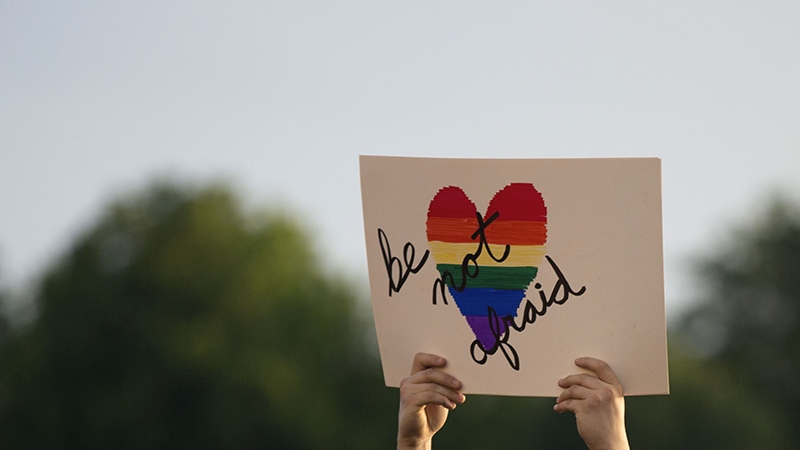
Studies show that sexual minority youth are much more susceptible to unsafe or even violent situations than heterosexual youth. Photo by Ruben Ramirez-Castillo
Studies show that sexual minority youth are much more susceptible to unsafe or even violent situations than heterosexual youth. Photo by Ruben Ramirez-Castillo
Wesley Rinhart knows how stigma and violence hurt young gay men like him.
After he came out as gay at 15, Rinhart said his stepfather packed his belongings, left them at the front door and told him to go.
Rinhart slept under the South Tejon Street bridge in Colorado Springs for a few weeks. He bounced between a group home and the homes of men whom he thought he loved but who eventually took advantage of him, Rinhart said, and even physically abused him.
Recently, he hopped a bus out of Colorado and now lives with his father.
“My life has pretty much been a roller coaster ride,” Rinhart said.
In Colorado, lesbian, gay, bisexual and transgender (LGBT) young people suffer more violence and are more likely to engage in risky behaviors than their straight peers. LGBT youth are less likely to eat breakfast and exercise daily, and more likely to use tobacco, alcohol, marijuana and drugs such as cocaine and methamphetamines, according to the 2015 Healthy Kids Colorado survey that tracked behavior for Colorado’s middle and high-schoolers. Among all Colorado youth who responded to the survey, LGBT youth were more likely than heterosexual and non-transgender youth to be bullied or experience threats to their safety, and to have considered or attempted suicide.
Nationally, the picture is just as bleak. In August, the Centers for Disease Control and Prevention published the first national study of lesbian, gay, bisexual and questioning youth and unhealthy behavior. (Transgender youth and data from Colorado were not included in the study.)
The research found that lesbian, gay and bisexual high schoolers across the United States were twice as likely to have been threatened or injured with a weapon at school or experienced cyberbullying. They were more than twice as likely to avoid going to school because they didn’t feel safe. Homosexual or bisexual youth were three times as likely to have seriously considered suicide, and over four and a half times as likely as their heterosexual peers to have attempted it.
Rinhart turned to marijuana, meth and more because he wanted to “feel again.” The drugs were a way to self-medicate to cope with traumatic experiences and “feel happy.”
“I’ve tried every drug in Colorado Springs possible,” he said. “Growing up, I didn’t feel loved, I didn’t feel cared for.”
Taking risks is part of natural youth brain development, said Mary Malia, executive director of Inside/Out Youth Services in Colorado Springs. The organization is a community center and safe space for LGBT and questioning young people.
Many LGBT and questioning young people feel isolated or unable to express their true selves at school, in their families or communities, Malia said.
“LGBTQ youth take more risks because they’re so desperate to feel connected in some fashion,” she said.
That may mean staying in abusive romantic relationships because it’s better than being alone, or falling on drugs and alcohol to numb the pain of social isolation, Malia said.
Dating violence is a stark reality for many sexual minority youth. According to the CDC study published this year, 8 percent of heterosexual students had been hurt by someone they were dating while 18 percent of LGB students and 25 percent of questioning students reported the same.
When you don’t feel safe to express your gender identification or sexual orientation publicly, or you get bullied or teased for being different—and you don’t see a way out—“risky behaviors don’t seem risky,” Malia said. Instead, they’re how some trapped young people assert power over their lives.
What can help are educated parents and accepting school systems that recognize the diversity of their students and refuse to permit harassment.
Across Colorado, approximately 220 gay-straight alliances or gay-straight-trans alliances have formed in schools to stand up for LGBT youth and promote an accepting environment, One Colorado Executive Director Daniel Ramos said. Schools also need to train teachers to intervene when students are bullied. Around 65 percent of the state’s schools have policies that ban bullying specifically for reasons of sexual orientation or gender identification, Ramos said.
Living in fear jeopardizes students’ ability to learn and become academically competent, said Nan Kratohvil, former co-chair of the Colorado chapter of the Gay, Lesbian & Straight Education Network (GLSEN). Kratohvil taught English and humanities at Cherry Creek High School in Denver and co-chaired the local chapter of GLSEN from 1995 until this year.
“The kid that is planning his escape route from class is not focusing on the class,” she said.
Rinhart found support through the gay-straight alliance club at Palmer High School in Colorado Springs (now known as the Gay/Straight/Trans Alliance) where he attended for two years. He found a group of people with similar back stories who he could get along with and who got along with him.
Now 19 years old, Rinhart prefers not to talk about the violence he’s experienced at the hands of his previous boyfriends. Instead, he focuses on how he’s been able to survive and overcome the chronic trauma he’s endured in his life.
“I have that mentality that nobody is going to bring me down, no matter how hard they try,” he said.